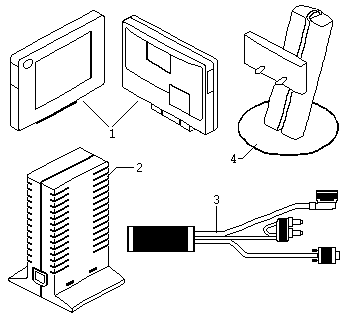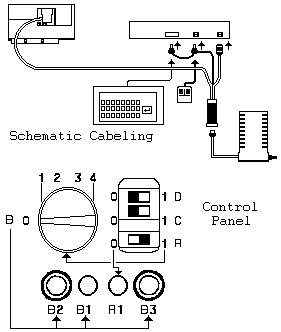9507 Color Display Adjustments

© Copyright IBM Corp.
9507 Color Display Parts
|
Index
|
FRU P/N
|
| 1 Display Panel |
39G5742
|
| 2 Power-supply unit |
39G2280
|
| 3 Cable-concentrator |
39G5727
|
| 4 Lift/tilt/swivel stand |
39G2279
|
User Adjustable Effects
The two effects which are easiest to identify and adjust are
Vertically off-center image
Horizontally off-center image
Other effects are more subtle. In particular, liquid-crystal displays
driven by an analog source exhibit certain optical effects which may, in
some applications and workplace environments, over a period of time become
distracting.
They are liable to be perceived by the user as:
Slight tremors up or down the vertical
lines of tables, boxes and text characters, the tremors may seem to be
moving or stationary.
A faint, linear, horizontal, background
quiver in areas of solid color.
Slight ghost-imaging or smearing of
horizontal lines.
They indicate that the optimum internal settings of the display
panel installed by the factory need to be fine-tuned to the application
or workplace lighting conditions.
However there are some colors which liquid- crystal displays cannot
represent easily when driven by an analog source. The display creates these
colors by switching alternate pels on and off, or half off. If you cannot
get an acceptable rendering of a particular color, the user may have to
choose another.
Non adjustable Effects
Liquid-crystal displays are liable to experience condition refereed
to as failed sub-pixels. The user becomes aware of them as dark or bright
pinpoints which appear, in every application, at the same place, or places,
on the screen.
You cannot adjust these pinpoints or remove them. The design specification
for the IBM 9507 Color Display allows a small number of failed pixels,
comprising a mix of on-pels and off-pels.
9507 Color Display Adjustment .
The Back-of Panel Controls. (Picture show factory-set positions)
Fine Tuning Procedure.
Only attempt to fine tuning when stable temperature conditions
have been established for the IBM 9507 Color Display. This will generally
mean that the display panel has been running for at least 20 minutes.

A (Looks like R)
A1(Looks like R1)
B
B1
B2
B3
C
D
© Copyright IBM Corp.
1. Open flap at back of display panel to reveal the fine
tuning controls.
2. Ensure that the slide-switch A is set to Position 1,
and all other switches are also at factory-set positions, as shown in the
diagram.
3. Read the following notes before you continue.
Position 0 of slide-switch
A, slide-switch D, and the recessed pushbutton A1, are for factory use.
The internal functions associated
with rotary switch B are identified in 'The Back-of- Panel Controls' described
below.
For each function selected
with the rotary switch B pushbuttons B3 and B3 are used to effect a shift,
in opposite directions, from the current internal settings. The shift in
settings affects the characters on the screen. One press causes a one-increment
shift in the value of setting.
The recessed pushbutton B1 is
a RESET pushbutton. When it is pressed, the settings installed at the factory
are re-installed. You may press pushbutton B1 (for example, with the tip
of a pen) at any time during fine tuning at any function selected
with rotary switch B.
|
Switch
|
Function
|
|
A
|
Position 0 - factory use only. |
|
Position 1 - enable user adjustment. |
|
A1
|
Factory use only |
|
B
|
0 to adjust the clock-to-video phase relation. |
|
2 to adjust the horizontal image centering. |
|
3 to adjust the vertical image centering. |
|
4 to adjust the max. white signal level. |
|
Position 1 factory use only |
|
B1
|
Reset all values to factory setup. |
|
B2
|
Decrease value of function selected with rotary switch B. |
|
B3
|
Increase value of function selected with rotary switch B. |
|
C
|
Position 0 - For auto install of full-screen image at factory. |
|
Position 1 - Expand or compress the image. |
|
D
|
Factory use only (set at position 0). |
From Peter
It really runs best in 16-colors VGA mode. Greyscales
cause a lot "turbulences" on the display - running horizontal lines and
such. Don't forget that the display is "analog attached": the signal from
the video card is converted into analog signals and back to digital in
the monitor. No comparison with modern large scale TFT LCDs, which have
digital direct drive without the DA-AD conversion stage.
9595 Main Page
|

